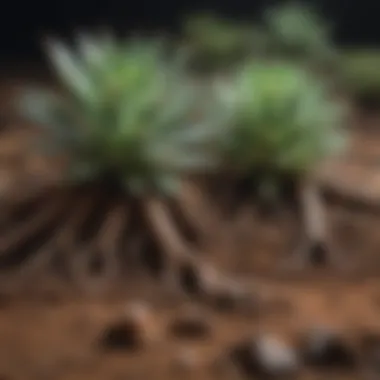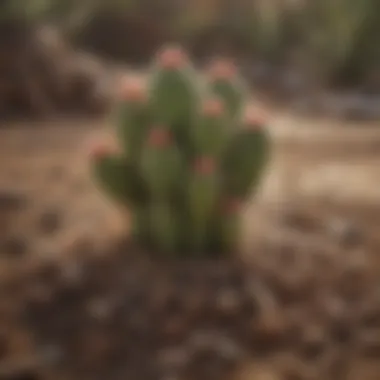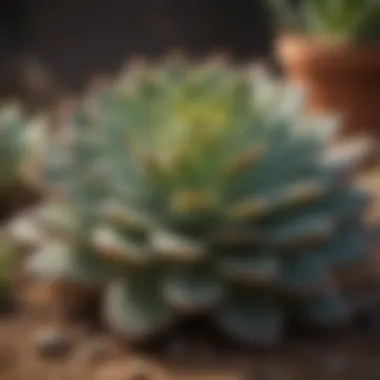The Ultimate Guide to Choosing the Best Soil Mix for Cactus and Succulents


Soil Composition Analysis
When delving into the realm of cultivating cactus and succulents, the pivotal starting point is deciphering the intricacies of soil composition. The foundation for thriving desert plants lies in the balance of drainage capacity and nutrient richness within the soil mix. Understanding the specific characteristics that cater to these arid-dwelling species is paramount in fostering optimal growth and health.
Importance of Well-Draining Soil
The arid nature of cacti and succulents emphasizes the necessity of soil with exceptional drainage capabilities. Excess moisture retention can lead to root rot and ultimately jeopardize the plant's vitality. By crafting a soil mix that facilitates swift water movement, you are safeguarding against common risks associated with waterlogged conditions.
Nutrient-Rich Soil Components
Diving deeper into the soil mix intricacies, the nutrient composition plays a crucial role in sustaining the well-being of cactus and succulents. Balancing mineral components like sand, perlite, and organic matter aids in replicating the native habitats of these plants, ensuring they receive essential nutrients for robust growth.
Soil Selection Techniques
When embarking on the soil selection journey for your desert flora companions, several techniques can aid in formulating the optimal soil mix. From assessing drainage capabilities to understanding the requirements of different cactus and succulent species, each step contributes to the holistic care regimen for these resilient plants.
Container Selection Considerations
The vessel housing your cactus or succulent is a crucial determinant in their well-being. The container's size, material, and drainage holes all interplay to create a conducive environment for healthy root development and thriving foliage.
Mixing Ratios and Experimentation
Creating an ideal soil mix involves a dash of experimentation and a scientific approach. By blending varying ratios of mineral components and organic matter, you can tailor the soil mix to suit the specific needs of your plant collection. Embracing this trial-and-error process fosters a deeper understanding of your plants' preferences and enhances your gardening skills.
The End
Understanding the Needs of Cactus and Succulents
Cactus and succulents, with their unique water-storing adaptations, require a specialized soil mix that caters to their distinct needs. Understanding the needs of these plants is crucial in ensuring their optimal growth and health. By delving into the specifics of soil composition, drainage capabilities, and nutrient retention, gardeners can provide the ideal environment for their beloved desert plants. Without a comprehensive understanding of what cactus and succulents require, it becomes challenging to cultivate them successfully. This section will shed light on the pivotal factors that contribute to the viability of these plants in different growing conditions.
Importance of Soil Mix
Drainage
Drainage plays a pivotal role in the cultivation of cactus and succulents, as these plants are highly susceptible to root rot if left in waterlogged soil. The key characteristic of good drainage is the ability to allow excess water to escape rapidly, preventing the roots from sitting in stagnant moisture. This feature is crucial for arid plants like cacti, as it mimics their natural habitat where sudden downpours are quickly followed by arid conditions. Practicing proper drainage ensures that cactus and succulents thrive in an environment that resembles their native desert homes.
Aeration
Aeration is vital for cactus and succulents as it promotes healthy root growth and helps prevent soil compaction. An effective aeration system allows oxygen to reach the roots, facilitating crucial metabolic processes. The porous nature of certain soil components aids in maintaining an oxygen-rich environment around the root zone, enhancing overall plant vitality. This ensures optimal nutrient uptake and fosters robust growth in cactus and succulents.


Nutrient Retention
Nutrient retention in the soil mix serves as a reservoir for essential minerals that cactus and succulents require for their growth. While these plants are adapted to thrive in nutrient-deficient environments, a balanced mix that retains key nutrients can support their long-term health. Nutrient-rich soil amendments like compost or organic matter can enhance the overall vitality of cacti and succulents, providing them with a supplementary nutrient source in lean conditions.
Specific Requirements of Cactus and Succulents
Low Moisture Retention
Cactus and succulents thrive in soil mixes that have low moisture retention, preventing excessive water accumulation around their roots. The key characteristic of low moisture retention is the ability to dry out quickly after watering, mimicking the sporadic rainfall patterns of arid environments. This feature ensures that cacti and succulents avoid prolonged exposure to moisture, reducing the risk of root diseases caused by fungal pathogens.
Well-Draining
Well-draining soil is essential for cactus and succulents to prevent waterlogged conditions that can lead to root rot. The key characteristic of well-draining soil is its ability to quickly disperse excess water, maintaining a balanced moisture level conducive to healthy plant growth. This feature ensures that cacti and succulents receive adequate hydration without the risk of suffocating their roots in standing water.
Slightly Acidic pH
Cactus and succulents prefer soil with a slightly acidic pH level, reflecting the conditions of their native desert habitats. The key characteristic of a slightly acidic pH is its compatibility with the plants' root systems, promoting optimal nutrient uptake. This feature enables cacti and succulents to access essential minerals more efficiently, supporting their growth and resilience in varying environmental conditions.
Key Components of an Ideal Soil Mix
In the realm of cultivating cactus and succulents, the composition of the soil mix stands as a pivotal factor for the plants' prosperity and flourishing. Understanding the key components that form an ideal soil mix is essential for achieving the optimal growth conditions for these species. The significance of this article lies in shedding light on the crucial elements that construct the foundation of a balanced and nutritious soil mix, tailored specifically to meet the needs of cacti and succulents. By exploring the diverse components that contribute to the ideal soil mix, including various types of soil, organic matter, and mineral additives, enthusiasts can hone their gardening skills and provide a conducive environment for their beloved plants.
Types of Soil
Potting Soil
Potting soil emerges as a versatile and widely favored component in creating an ideal soil mix for cactus and succulents. The key characteristic that distinguishes potting soil is its unique blend of organic materials, such as peat moss and compost, designed to promote root health and growth. Renowned for its ability to retain moisture while ensuring adequate drainage, potting soil serves as a beneficial choice within the realm of soil mixtures for these arid-loving plants. Despite its advantages in fostering plant vitality, potting soil may present some drawbacks, such as the risk of compaction if not adequately aerated, demanding careful attention in its application within this context.
Perlite
Introducing perlite into the soil mix enriches the overall composition by enhancing aeration and drainage capacities, pivotal aspects for cactus and succulents' well-being. With its lightweight and porous nature, perlite facilitates optimal airflow to the plant roots, limiting the chances of waterlogging and root rot. Its unique feature of promoting soil aeration underscores its value in maintaining a healthy growing environment. However, perlite's downside may manifest in its tendency to float to the top of the soil surface, necessitating mindful handling during the mixing process to ensure even distribution throughout the mixture.
Sand
The inclusion of sand in the soil mix contributes to improving drainage efficiency and supporting root stability for cactus and succulents. Characterized by its coarse texture, sand aids in preventing water stagnation, safeguarding the plants against the perils of excess moisture. Its ability to enhance soil structure and reduce compaction accentuates sand as a favorable choice for cultivating these arid-adapted specimens. Nonetheless, the disadvantages of using sand may surface in certain contexts, such as its potential to impede water retention capabilities when utilized in excessive proportions.
Pumice
The integration of pumice within the soil mix promotes optimal drainage and aeration, offering a lightweight and porous medium that benefits the root systems of cactus and succulents. Noteworthy for its ability to mitigate soil compaction and enhance moisture regulation, pumice stands out as a valuable addition to the soil mixture. Its unique feature of providing a stable yet breathable environment for plant roots positions pumice as a commendable choice. However, users should exercise caution during pumice incorporation, considering its abrasive nature that might pose challenges during the handling process within this specialized gardening context.


Organic Matter
Coconut Coir
Coconut coir comprises a prominent component in the realm of organic matter, contributing significantly to the structure and moisture retention capacity of the soil mix for cactus and succulents. Renowned for its excellent water retention properties and sustainable sourcing, coconut coir serves as a beneficial and eco-friendly choice for nurturing these arid-adapted plants. The unique feature of coconut coir lies in its ability to improve soil aeration while offering a renewable alternative to traditional peat moss. Despite its advantages, coconut coir may exhibit limitations in nutrient provision, necessitating supplemental fertilization to ensure the plants' optimal growth and vitality.
Peat Moss
Peat moss holds a pivotal role in enhancing the moisture retention capabilities of the soil mix, crucial for sustaining the water requirements of cactus and succulents. Recognized for its acidity-neutralizing properties and capacity to improve soil texture, peat moss emerges as a valuable component in promoting healthy root development and growth. Its unique feature lies in its ability to aid in disease prevention by fostering a favorable environment for beneficial microorganisms. However, the disadvantages of peat moss may arise from its non-renewable sourcing and potential environmental impacts, urging enthusiasts to consider sustainable alternatives within the spectrum of organic matter components.
Mineral Additives
Vermiculite
Incorporating vermiculite into the soil mix amplifies its water retention capacity and aids in nutrient absorption, fundamental for the well-being of cactus and succulents. The key characteristic of vermiculite lies in its ability to improve soil structure while promoting aeration and moisture retention, ideal for arid-adapted plants. Its unique feature of enhancing the overall texture of the soil mix underscores its significance in creating a conducive planting medium. Nevertheless, the disadvantages of vermiculite may become evident in its relatively high cost compared to other mineral additives, prompting users to consider budgetary factors in its utilization within this specialized gardening context.
Limestone
The inclusion of limestone in the soil mix contributes to regulating soil pH levels and enhancing nutrient availability, crucial for optimizing plant growth for cactus and succulents. Highlighted for its alkalizing properties and capacity to counteract soil acidity, limestone serves as a beneficial choice for balancing the pH requirements of these arid-loving species. Its unique feature of promoting root development by mitigating soil acidity positions limestone as an essential mineral additive. However, precautions should be taken in limestone application, considering its potential to raise pH levels drastically if not utilized judiciously within the context of nurturing cactus and succulents.
Creating Your Own Soil Mix
In this intricate realm of cactus and succulent cultivation, the art of creating a bespoke soil mix emerges as a pivotal juncture. The significance of crafting your own soil amalgamation lies in the tailored precision it offers to address the unique exigencies of these arid-loving plants. By developing a personalized soil composition, one delves into a meticulous process that harmonizes with the specific requirements of cacti and succulents, thereby elevating the nurturing experience to a realm of bespoke horticulture.
Crafting a soil mix warrants a meticulous understanding of the fundamental components necessitated by cacti and succulents. The process entails a delicate balance of various elements, where one must consider factors such as drainage capabilities, moisture retention efficiency, and pH balance. These intricate aspects underscore the bespoke nature of creating a soil mix, emphasizing the tailored approach required to meet the unique needs of these arid-dwelling botanical wonders. Through the act of formulating a personalized soil concoction, one not only tends to the physical needs of the plants but also engages in a harmonious dialogue with nature's design.
Delving deeper into the realm of DIY options within the creation of a soil mix, one encounters a landscape rich in possibilities and formulations. The basic recipe forms the cornerstone of this endeavor, offering a foundational structure on which to build the ideal soil mix for cacti and succulents. This fundamental blend typically comprises a combination of potting soil, sand, and perlite, serving as the backbone of nutrient retention and aeration essential for optimal plant growth.
Furthermore, the beauty of DIY soil mixes lies in their adaptability to different plant varieties. The adjustments based on plant variety allow for a nuanced approach, where specific species' needs can be catered to with precision. By customizing the soil mix based on the unique characteristics of different cacti and succulents, one ensures an ideal environment for growth and vitality. This tailored strategy not only nurtures the plants effectively but also fosters a deeper understanding of their individualistic requirements within the broader spectrum of horticulture.
Commercial Soil Mix Options
When delving into the realm of soil mix options for cactus and succulents, considering commercial options is paramount. These prefabricated mixes offer a blend of components curated to meet the specific needs of these unique plant species. Commercial soil mixes are crafted to provide ideal drainage, aeration, and nutrient retention, essential for the health and vigor of cacti and succulents. As such, they alleviate the hassle of formulating a custom blend and ensure a consistent quality that promotes optimal growth and blooming. Additionally, commercial mixes save time and effort, making them a convenient choice for both novice and experienced gardeners.
Popular Brands
Espoma
Espoma stands out as a reputable brand known for its commitment to quality and excellence in the realm of soil mixes. Their signature blend offers impeccable drainage, crucial for the well-being of cacti and succulents. Espoma's mix is lauded for its exceptional aeration properties, allowing roots to thrive in oxygen-rich environments. Gardeners value Espoma for its organic composition, free from harmful chemicals that could impede plant growth. While slightly costly, Espoma's mix translates into healthy and robust plants, justifying the investment in this superior product.


Miracle-Gro
Miracle-Gro emerges as a household name synonymous with gardening success, including soil mixes tailored for cactus and succulents. Their mix excels in providing a well-balanced pH level essential for the optimal growth of these plants. Miracle-Gro's blend guarantees a rich nutrient content that nourishes plants consistently, fostering vibrant blooms and resilient foliage. One notable drawback is its higher price point compared to other brands, yet the quality and results it delivers make it a preferred choice among discerning gardeners.
Bonsai Jack
Bonsai Jack positions itself as a reliable brand offering specialized soil blends designed for cacti and succulents. The key characteristic of Bonsai Jack's mix lies in its exceptional drainage capacity, preventing waterlogging and root rot - common issues in these plants. This feature ensures that roots remain healthy and fungus-free, promoting overall plant vitality. The unique selling point of Bonsai Jack's mix is its gravel-based composition, which aids in maintaining soil structure and aeration, contributing to thriving, resilient plants. While slightly harder to find in local stores, Bonsai Jack's mix is worth the effort for its exceptional benefits.
Comparison of Commercial Mixes
Nutrient Content
The nutrient content of a commercial soil mix profoundly impacts the growth and development of cactus and succulents. A blend rich in essential nutrients such as nitrogen, phosphorus, and potassium can fuel robust plant growth, vibrant blooms, and sturdy foliage. Ensuring adequate nutrition in a soil mix is crucial for long-term plant health and blooming cycles, making it a defining factor for gardeners seeking optimal outcomes.
Price Point
The price point of commercial soil mixes plays a significant role in determining the accessibility and affordability for gardening enthusiasts. While some premium brands command a higher cost due to superior quality and nutrient composition, budget-friendly options cater to those seeking economical yet effective solutions. Balancing cost with quality is essential when selecting a commercial mix, ensuring that both plant health and financial considerations are met satisfactorily.
Availability
The availability of commercial soil mixes in local markets or online platforms dictates the ease of procurement for gardeners. Brands that offer widespread availability make it convenient for enthusiasts to access their preferred mixes promptly, supporting consistent plant care practices. Conversely, limited availability may hinder gardeners in obtaining their desired soil blends, necessitating alternative options or additional effort to source the optimal mix for their cactus and succulents.
Maintaining Healthy Soil Conditions
Maintaining healthy soil conditions is a critical aspect of cultivating thriving cactus and succulents. Effective soil management ensures optimal growth and sustainability for these unique plants. By focusing on the right watering practices and fertilization tips, you can create an environment that supports their specific needs. Adequate moisture levels and nutrient balance are key determinants of success in preserving the health of your cactus and succulents.
Watering Practices
Frequency
Understanding the frequency of watering is paramount in maintaining healthy soil conditions for cactus and succulents. These plants thrive in arid environments, requiring infrequent watering to prevent root rot and fungal diseases. Overwatering can be detrimental, leading to stagnant water in the soil, depriving the plants of essential oxygen. Therefore, adopting a sparse watering schedule promotes proper growth and resilience in cactus and succulents.
Avoiding Waterlogged Soil
Avoiding waterlogged soil is imperative for the well-being of cactus and succulents. Excess water retention can hinder root development and cause irreversible damage to these plants, often resulting in wilting or rotting. By ensuring proper drainage in your soil mix and using containers with drainage holes, you can prevent waterlogging and help cactus and succulents thrive in a well-aerated environment.
Fertilization Tips
Balanced Nutrients
Providing balanced nutrients is essential for the sustained health of cactus and succulents. These plants have specific mineral requirements that, when met adequately, promote vigorous growth and vibrant blooms. A balanced fertilizer with a lower nitrogen content is recommended to prevent excessive foliage growth. It is essential to follow a consistent fertilization schedule to support the unique nutritional needs of cactus and succulents, ensuring optimal development and longevity.
Seasonal Adjustments
Making seasonal adjustments to fertilization practices ensures that cactus and succulents receive the appropriate nutrients at different growth stages. During the active growing season, increasing the frequency of fertilization can support robust development. In contrast, reducing fertilizer application during the dormancy period prevents excessive nutrient uptake, aligning with the plants' natural cycles. By adjusting fertilization based on seasonal variations, you can enhance the overall health and vitality of your cactus and succulents.







